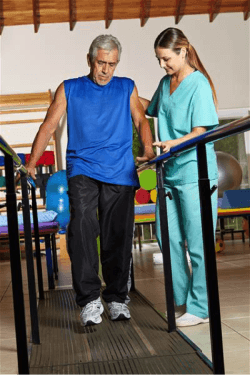Effects of Biofeedback for Functional Movement in TKA patients: Useful or Not?

I took a look at the latest JOSPT article that was presented on line a head of print.
| Effects of Weight-Bearing Biofeedback Training on Functional Movement Patterns Following Total Knee Arthroplasty: A Randomized Controlled Trial |
| Cory L. Christiansen, Michael J. Bade, Bradley S. Davidson, Michael R. Dayton, and Jennifer E. Stevens-Lapsley |
It took a look at using biofeedback to train post-op TKA patients to weight bear evenly on the involved and uninvolved legs. I see many TKA patients and it is easy to see that in sit to stand and squatting activities, patients continue to put more weight on the uninvolved knee.
The authors organized a good randomized controlled trial with 26 subjects in each group (RELOAD and CONTROL) and dose matched exercise programs for the control group. They looked at the patients 6 and 26 weeks out. The experimental group had biofeedback training to encourage them to use the involved leg. The subjects were tested in a five times sit to stand (FTSST) and walking as well as sit to stand speed, walking speed and lower limb joint moments.
‘No between-group differences were found in weight bearing ratios. FTSST time improved in the RELOAD group compared to the CONTROL group at 6 (P=.021) and 26 weeks (P=.021) and there was a tendency for improved walking speed in the RELOAD group at 26 weeks (P=.068). There were no between-group differences in knee extension moment during the FTSST. Surgical-limb knee extension moments during walking increased from baseline to 26 weeks in the RELOAD group and decreased in the CONTROL group (P=.008).’
So I guess back to the drawing board to figure a way to even out weight distribution in post op TKA’s in sit to stand. I got to thinking about this…you know, every step the patient walks, they are full weight bearing each step on each leg. Maybe we just need to make sure they do this with normal timing, step length, time in weight bearing and forget about what happens in sit to stand…the research supports that as you see above with improved extensions moments.

